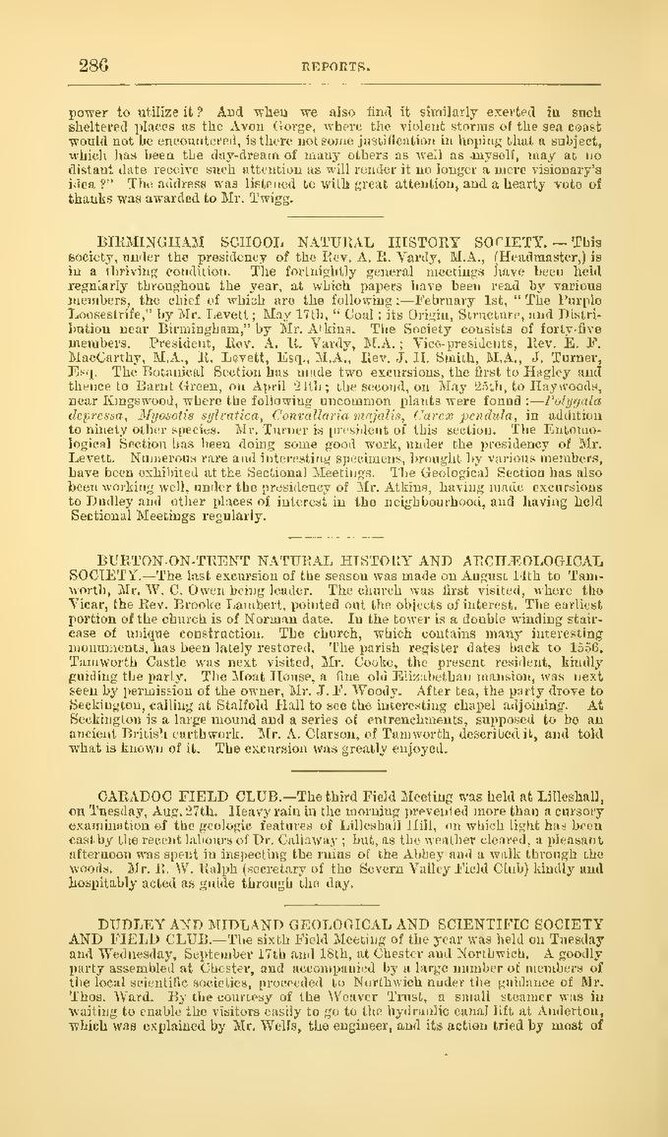power to utilize it? And when we also find it similarly exerted in such sheltered places us the Avon Gorge, where the violent storms of the sea coast would not he encountered, is there not some justification in hoping that a subject, which has been the day-dream of many others as well as myself, may at no distant date receive such attention as will render it no longer a mere visionary's idea?" The address was listened to with great attention, and a hearty vote of thanks was awarded to Mr. Twigg.
Birmingham School Natural History Society.— This society, under the presidency of the Rev. A. R. Vardy, MA., (Headmaster,) is in a thriving condition. The fortnightly general meetings have been held regularly throughout the year, at which papers have been read by various members, the chief of which are the following:—February 1st, "The Purple Loosestrife," by Mr. Levett; May 17th, "Coal: its Origin, Structure, and Distribution near Birmingham,” by Mr. Atkins. The Society consists of forty-five members. President, Rev. A. R. Vardy, MLA.; Vice-presidents, Rev. E. F. MacCarthy, M.A., R. Levett, Esq, M.A., Rev. J. H. Smith, M.A., J. Turner, Esq. The Botanical Section has made two excursions, the first to Hagley and thence to Barnt Green, on April 28th; the second, on May 25th, to Haywoods, near Kingswood, where the following uncommon plants were found:—Polygala depressa, Myosatis sylvatica, Convallaria majalis, Carex pendula, in addition to ninety other species. Mr. Turner is president of this section, The Entomological Section bas been doing some good work, under the presidency of Mr. Levett. Numerous rare and interesting specimens, brought by various members, have been exhibited at the Sectional Meetings. The Geological Section has also been working well, under the presidency of Mr. Atkins, having made excursions to Dudley and other places of interest in the neighbourhood, and having held Sectional Meetings regularly.
Burton-On-Trent Natural History and Archæological Society.—The last excursion of the season was made on August 14th to Tamworth, Mr. W. C. Owen being leader. The church was first visited, where the Vicar, the Rev. Brooke Lambert, pointed out the objects of interest. The earliest portion of the church is of Norman date. In the tower is a double winding staircase of unique construction. The church, which contains many interesting monuments, has been lately restored. The parish register dates back to 1556. Tamworth Castle was next visited, Mr. Cooke, the present resident, kindly guiding the party. The Moat House, a fine old Elizabethan mansion, was next seen by permission of the owner, Mr. J. F. Woody. After tea, the party drove to Seckington, calling at Stafford Hall to see the interesting chapel adjoining. At Seckington is a large mound and a series of entrenchments, supposed to be an ancient British earthwork. Mr. A. Clarson, of Tamworth, described it, and told what is known of it. The excursion was greatly enjoyed.
Caradoc Field Club.—The third Field Meeting was held at Lilleshall, on Tuesday, Aug. 27th, Heavy rain in the morning prevented more than a cursory examination of the geologic features of Lilleshail Hill, an which light has been cast by the recent labours of Dr, Callaway; but, as the weather cleared, a pleasant afternoon was spent in inspecting the ruins of the Abbey and a walk through the woods, Mr. R. W. Ralph (secretary of the Severn Valley Field Club} kindly and hospitably acted as guide through the day.
Dudley and Midland Geological and Scientific Society And Field Club.—The sixth Field Meeting of the year was held on Tuesday and Wednesday, September 17th and 18th, at Chester and Northwich. A goodly party assembled at Chester, and accompanied by a large number of members of the local scientific societies, proceeded to Northwich nuder the guidance of Mr. Thos. Ward. By the courtesy of the Weaver Trust, a small steamer was in waiting to enable the visitors easily to go to the hydraulic canal lift at Anderton which was explained by Mr. Wells, the engineer, and its action tried by most of
